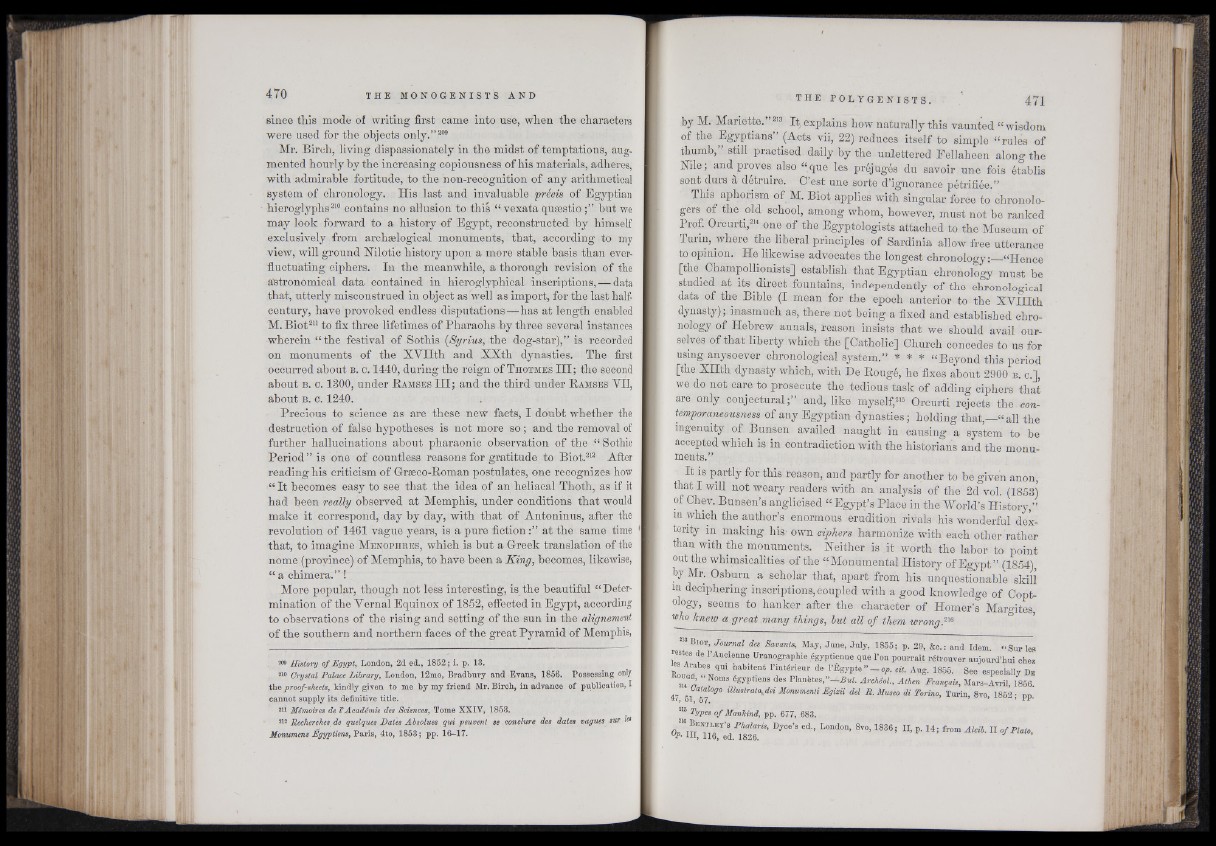
since this mode oi writing first came into use, when the characters
were used for the objects only.”209
Mr. Birch, living dispassionately in the midst of temptations, augmented
hourly by the increasing copiousness of his materials, adheres,
with admirable fortitude, to the non-recognition of any arithmetical
system of chronology. His last and invaluable précis of Egyptian
hieroglyphs210 contains no allusion to this “ vexata quæstio ;” but we
may look forward to a history of Egypt, reconstructed by himself
exclusively from archælogical monuments, that, according to my
view, will ground Nilotic history upon a more stable basis than ever-
fluctuating ciphers. In the meanwhile, a thorough revision of the
astronomical data contained in hieroglyphical inscriptions, — data
that, utterly misconstrued in object as well as import, for the last half-
century, have provoked endless disputations—has at length enabled
M. Biot211 to fix three lifetimes of Pharaohs by three several instances
wherein “ the festival of Sothis (Syrius,, the dog-star),” is recorded
on monuments of the XVHth and XXth dynasties. The first
occurred about b. c. 1440, during the reign of T hotmes HI; the second
about b. c. 1300, under R amses IH; and the third under R amses V IL,
about b. c. 1240.
Precious to science as are these new facts, I doubt whether the
destruction of false hypotheses is not more so; and the removal of
further hallucinations about pharaonic observation of the “ Sothic
Period” is one of countless reasons for gratitude to Biot.212 After
reading his criticism of Græco-Roman postulates, one recognizes how
“ It becomes easy to see that the idea of an heliacal Thoth, as if it
had been really observed at Memphis, under conditions that would
make it correspond, day by day, with that of Antoninus, after the
revolution of 1461 vague years, is a pure fiction at the same time
that, to imagine M enophres, which is but a Greek translation of the
nome (province) of Memphis, to have been a King, becomes, likewise,
“ a chimera.” !
More popular, though not less interesting, is the beautiful “Determination
of the Vernal Equinox of 1852, effected in Egypt, according
to observations of the rising and setting of the sun in the alignement
of the southern and northern faces of the great Pyramid of Memphis,
209 History of Egypt, London, 2d ed., 1852; i. p. 18.
210 Crystal Palace Library, London, 12mo, Bradbury and Evans, 1856. Possessing only
the proof-sheets, kindly given to me by my friend Mr. Birch, in advance of publication, 1
cannot supply its definitive title.
211 Mémoires de VAcadémie des Sciences, Tome XXIV, 1853.
212 Recherches de quelques Dates Absolues qui peuvent se conclure des dates vagues sur la
Monumens Égyptiens, Paris, 4to, 1853; pp. 16-17.
by M. Mariette. 2,3 It, explains how naturally this vaunted “wisdom
of the Egyptians (Acts vii, 22) reduces itself to simple “ rules of
thumb, still practised daily by the unlettered Fellaheen along the
Nile; and^proves also “ que les préjugés du savoir une fois établis
sont durs a détruire. C’est une sorte d’ignorance pétrifiée.”
This aphorism of M. Biot applies with singular force to chronolo-
gers of the old school, among whom, however, must not be ranked
Prof. Orcurti,214 one of the Egyptologists attached to the Museum of
Turin, where the liberal principles of Sardinia allow free utterance
to opinion. He likewise advocates the longest chronology : “Hence
[the^ Champollionists] establish that Egyptian chronology must be
studied at its direct fountains, independently of the chronological
data of the Bible (I mean for the epoch anterior to the XVIHth
dynasty); inasmuch as, there not being a fixed and established chronology
of Hebrew annals, reason insists that we should avail ourselves
of that liberty which the [Catholic] Church concedes to us for
using anysoever chronological system.” * * * “Beyond this period
[the XHth dynasty which, with De Rougé, he fixes about 2900 b . c.],
we do not care to prosecute the tedious task of adding ciphers that
are only conjectural;” and, like myself,21? Orcurti rejects the contemporaneousness
of any Egyptian dynasties; holding that,—“ all the
ingenuity of Bunsen availed naught in causing a system to be
accepted which is in contradiction with the historians and the monuments.”
It is partly for this reason, and partly for another to be given anon,
that I will not weary readers with an analysis of the 2d vol. (1853)
of Chev. Bunsen’s anglicised “ Egypt’s Place in the World’s History,”
in which the author’s enormous erudition rivals his wonderful dexterity
m making his- own ciphers harmonize with each other rather
than with the monuments. Neither is it worth the labor to point
out the whimsicalities of the “Monumental History of Egypt” (1854),
by Mr. Osburn a scholar that, apart from his unquestionable skill
» deciphering inscriptions, coupled with a good knowledge of Copt-
ology, seems to hanker after the character of, Homer’s Margites,
who knew a great many things, hut all of them wrong.™
213 Bior, Journal des Savants, May, June, July, 1855; p. 29, &c.: and Idem. «Sur lea
res es de 1>Ancienne üranographie égyptienne que l’on pourrait rétrouver aujourd’hui chez
R ot , «l'beS„ qUi habitent 1,intérienr de l’Égypte-’- o p . cit. Aug. 1855. See especially Da
su r •égyptiens des PIai>ètes,”- iA u l Archêol., Athen Français, Mars-Avril, 1856.
47 ( T o j B iUusiraiQ>dei Monumenti Egizii del R. Museo di Torino, Turin, 8vo, 1852 ; pp.
215 Types of Mankind, pp. 677, 683. ■MfiS SIR DJ°e’a ed'. p°“d<>n, 8vo, 1836; II, p. 14; from Alcib. n of Plato,
VP- HI, 116, ed. 1826.